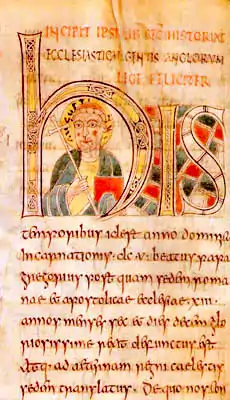The Middle Ages portal
.jpg.webp)
In the history of Europe, the Middle Ages or medieval period (also spelled mediæval or mediaeval) lasted approximately from the late 5th to the late 15th centuries, aligning with the post-classical period of global history. It began with the fall of the Western Roman Empire in 476 AD and ended with the fall of Constantinople in 1453 AD before transitioning into the Renaissance and then the Age of Discovery. The Middle Ages is the middle period of the three traditional divisions of Western history: antiquity, medieval, and modern. The medieval period is itself subdivided into the Early, High, and Late Middle Ages. Late medieval scholars at first called these the Dark Ages in contrast to classical antiquity; the accuracy of the term has subsequently been challenged.
Population decline, counterurbanisation, the collapse of centralized authority, invasion and the mass migration of tribes, which had begun in late antiquity, continued into the Early Middle Ages. The large-scale movements of the Migration Period, including of Germanic peoples, led to the rise of new kingdoms in Western Europe. In the 7th century, the Middle East and North Africa came under caliphal rule with the Arab conquests. The Byzantine Empire survived in the Eastern Mediterranean and advanced secular law through the Code of Justinian. In the West, most kingdoms incorporated extant Roman institutions, while the influence of Christianity expanded across Europe. The Carolingian dynasty of the Franks established the Carolingian Empire during the later 8th and early 9th centuries in Western Europe before it succumbed to internal conflict and external invasions from the Vikings from the north, Magyars from the east, and the Muslims from the south.
During the High Middle Ages, which began after 1000, the population of Europe increased greatly as technological and agricultural innovations allowed trade to flourish and the Medieval Warm Period climate change allowed crop yields to increase. Manorialism, the organisation of peasants into villages that owed rent and labour services to the nobles, and feudalism, the political structure whereby knights and lower-status nobles owed military service to their overlords in return for the right to rent from lands and manors, were two of the ways society was organised in the High Middle Ages. This period also saw the formal division of the Catholic and Orthodox churches, with the East–West Schism of 1054. The Crusades, which began in 1095, were military attempts by Western European Christians to regain control of the Holy Land from Muslims and also contributed to the expansion of Latin Christendom in the Baltic region and the Iberian Peninsula. Kings became the heads of centralised nation states, reducing crime and violence but making the ideal of a unified Christendom more distant. In the West, intellectual life was marked by scholasticism, a philosophy that emphasised joining faith to reason, and by the founding of universities. The theology of Thomas Aquinas, the paintings of Giotto, the poetry of Dante and Chaucer, the travels of Marco Polo, and the Gothic architecture of cathedrals such as Chartres mark the end of this period.
The Late Middle Ages was marked by difficulties and calamities including famine, plague, and war, which significantly diminished the population of Europe; between 1347 and 1350, the Black Death killed about a third of Europeans. Controversy, heresy, and the Western Schism within the Catholic Church paralleled the interstate conflict, civil strife, and peasant revolts that occurred in the kingdoms. Cultural and technological developments transformed European society, concluding the Late Middle Ages and beginning the early modern period. (Full article...)
Selected article

At the close of the ninth century various competing kingdoms occupied the territory of modern Scotland, with Scandinavian influence dominant in the northern and western islands, Brythonic culture in the south west, the Anglo-Saxon or English Kingdom of Northumbria in the south-east and the Pictish and Gaelic Kingdom of Alba in the east, north of the River Forth. By the tenth and eleventh centuries, northern Great Britain was increasingly dominated by Gaelic culture, and by the Gaelic regal lordship of Alba, known in Latin as either Albania or Scotia, and in English as "Scotland". From its base in the east, this kingdom acquired control of the lands lying to the south and ultimately the west and much of the north. It had a flourishing culture, comprising part of the larger Gaelic-speaking world and an economy dominated by agriculture and by short-distance, local trade.
Selected biography

Augustine of Canterbury (circa first third of the 6th century – probably 26 May 604) was a Benedictine monk who became the first Archbishop of Canterbury in the year 597. He is considered the "Apostle to the English" and a founder of the English Church.
Augustine was the prior of a monastery in Rome when Pope Gregory the Great chose him in 595 to lead a mission, usually known as the Gregorian mission, to Britain to Christianize King Æthelberht and his Kingdom of Kent from their native Anglo-Saxon paganism. Kent was probably chosen because Æthelberht had married a Christian princess, Bertha, daughter of Charibert I the King of Paris, who was expected to exert some influence over her husband. Before reaching Kent the missionaries had considered turning back but Gregory urged them on, and in 597 Augustine landed on the Isle of Thanet and proceeded to Æthelberht's main town of Canterbury.
King Æthelberht converted to Christianity and allowed the missionaries to preach freely, giving them land to found a monastery outside the city walls. Augustine was consecrated as a bishop and converted many of the king's subjects, including thousands during a mass baptism on Christmas Day in 597. Pope Gregory sent more missionaries in 601, along with encouraging letters and gifts for the churches, although attempts to persuade the native Celtic bishops to submit to Augustine's authority failed. Roman bishops were established at London and Rochester in 604, and a school was founded to train Anglo-Saxon priests and missionaries. Augustine also arranged the consecration of his successor, Laurence of Canterbury. The archbishop probably died in 604 and was soon revered as a saint. (read more . . . )
Did you know...
- ...that a paillasse is a thin mattress filled with hay or sawdust and was commonly used in the middle ages?
- ...that a barbican is a tower or other fortification defending the drawbridge, usually the gateway?
- ...that a coif is a type of armored head-covering made out of chain-mail and worn under the helmet for extra protection?
- ...that a heriot is a payment owed to the lord of the manor by a serf’s family upon the serf’s death; usually the family’s best animal, such as a cow, horse or most commonly ox?
- ...that before 1066, it was noted in the Domesday Book, if one Welshman killed another, the dead man’s relatives could exact retribution on the killer and his family (even burning their houses) until burial of the victim the next day?
- ...that buboes are pus-filled egg-sized swellings of the lymph glands of the neck, armpits, and groin; typically found in cases of bubonic plague?
- ...that laws passed in the late 1300s aimed at maintaining class distinctions by prohibiting lower classes from dressing as if they belonged to higher classes?
- ...that Pier Gerlofs Donia, a 15th century Frisian freedom fighter of 7 feet tall was alleged to be so strong that he could lift a 1000 pound horse?
- ...that Edgar Ætheling was the last of the Anglo-Saxon Kings of England, but was only proclaimed, never crowned?
Selected image
 Eight phases of The Song of Roland in one picture. |
The Song of Roland is the oldest major work of French literature. It exists in various different manuscript versions, which testify to its enormous and enduring popularity in the 12th to 14th centuries.
Related portals
Subcategories
Topics
Medieval Armenia · History of Bosnia and Herzegovina (958–1463) · Bulgarian Empire · Britain in the Middle Ages · Byzantine Empire · Medieval Croatian state · Crusader states · History of the Czech lands in the Middle Ages · England in the Middle Ages · France in the Middle Ages · Germany in the Middle Ages · Italy in the Middle Ages · Kievan Rus′ · Poland in the Middle Ages · Portugal in the Middle Ages ·Romania in the Middle Ages · Scotland in the High Middle Ages · History of Medieval Serbia · Spain in the Middle Ages · Women in the Middle Ages · Kingdom of Hungary in the Middle Ages · Wales in the Middle Ages
Things you can do
 |
Here are some tasks awaiting attention:
|
WikiProjects
- WikiProject History
- Middle Ages WikiProject
- WikiProject Medieval Scotland
- WikiProject Military history/Medieval warfare task force
- WikiProject King Arthur
Associated Wikimedia
The following Wikimedia Foundation sister projects provide more on this subject:
-
 Commons
Commons
Free media repository -
 Wikibooks
Wikibooks
Free textbooks and manuals -
 Wikidata
Wikidata
Free knowledge base -
 Wikinews
Wikinews
Free-content news -
 Wikiquote
Wikiquote
Collection of quotations -
 Wikisource
Wikisource
Free-content library -
 Wikiversity
Wikiversity
Free learning tools -
 Wiktionary
Wiktionary
Dictionary and thesaurus